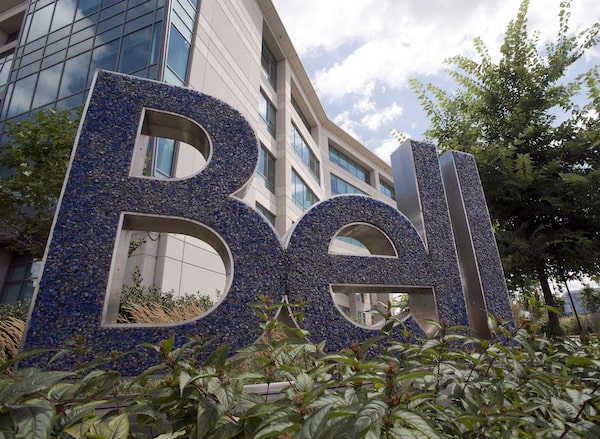
Bell Canada head office on Nun's Island, in Montreal, on Aug. 5, 2015.Ryan Remiorz/The Canadian Press
BCE Inc. boosted its quarterly revenue for the first time since the start of the pandemic, a trend the company’s chief executive officer says is likely to continue as consumers shop for new phones and the telecom accelerates its broadband network expansion.
Although it’s unclear when pandemic-related restrictions will lift, as many provinces are battling surging third waves of the virus, BCE president and CEO Mirko Bibic says the gradual reopening of Canada’s economy presents a number of growth opportunities for the telecom.
Since the start of the global health crisis, the sector has been hit with a steep drop in roaming revenue, which comes from fees that telecoms charge when wireless customers use their devices abroad. Stalled immigration, meanwhile, has hampered the wireless market’s growth.
“As COVID subsides and the borders reopen and immigration comes back and retail stores reopen, clearly there’s going to be growth there and we’ll be able to capture that pent-up demand,” Mr. Bibic said in an interview Thursday. He added that customers who have put off buying new mobile phones are “going to stop delaying and start getting in, particularly as more buzz is created around 5G.”
BCE lost bid for Shaw because of concerns over regulatory risk
CRTC ruling unlikely to shake up competition, prices, observers say
BCE’s subsidiary Bell Canada launched an early iteration of fifth-generation wireless technology in a handful of cities last June and expects to cover 50 per cent of the country’s population by the end of the year. To access the service, customers need to purchase 5G-capable phones such as the iPhone 12.
Mr. Bibic also highlighted Bell’s competitive strength amid a $20.4-billion merger agreement between two of the company’s rivals, Rogers Communications Inc. and Shaw Communications Inc. While Rogers and Shaw are in the midst of seeking regulatory approvals, a process that is expected to take until early next year, “we’ll continue to build, we’ll continue to be formidable competitors,” Mr. Bibic said during a conference call to discuss the company’s results.
A regulatory filing made public late last week revealed Bell had made an offer for Shaw before the Western Canadian cable company inked a deal with Rogers.
The Globe and Mail reported on Saturday that although Bell initially made a higher offer, it was unwilling to agree to a “hell or high water” clause that means it would have accepted any conditions set out by regulators – including selling off some of its own wireless assets – in order to gain approval, according to two sources familiar with the negotiations. The Globe did not identify the sources because they are not authorized to discuss the matter publicly.
Asked about Bell’s unsuccessful bid for Shaw, Mr. Bibic said the telecom will always capitalize on opportunities that make sense. “What you can take from this one ... is that our estimation was that the entire pricing and structure just didn’t make sense for our shareholders,” Mr. Bibic said in an interview.
BCE had $5.71-billion of revenue for the three-month period ended March 31, up 1.2 per cent from a year ago as it sold more premium phones and business telecom data equipment. Internet revenue grew 12 per cent as customers upgraded to faster speeds. The increase was partly offset by lower revenue from wireless roaming, media advertising and wireless spending by business customers.
The Montreal-based telecom had $687-million of profit during the first quarter, down 6.3 per cent from $733-million during the same period last year. Bell attributed the decline to higher severance, acquisition and other costs, as well as higher expenses related to depreciation and amortization.
The earnings amounted to 71 cents a share, down from 75 cents a year ago. After adjusting for items such as severance and acquisition costs, Bell had earnings of 78 cents a share, down from 79 cents during the first quarter of 2020.
The results were above analyst expectations of $5.62-billion of revenue and 73 cents of adjusted earnings per share, according to the consensus estimate from market researcher S&P Capital IQ.
Bell’s internet business added 21,208 net new retail customers, compared with 22,595 during the same quarter last year, while its IPTV service added 10,696 net new subscribers – the first quarter of year-over-year growth in two years.
Bell also added 32,925 net new postpaid mobile phone customers and lost 30,520 prepaid subscribers during the quarter. (Postpaid subscribers are those who are billed at the end of the month for the services they used, versus prepaid customers, who pay upfront for wireless services.)
Bell is also in the midst of an accelerated network expansion that Mr. Bibic says will drive future revenue growth. The telecom announced in February that it will boost its infrastructure spending to about $4.7-billion this year, from its usual $4-billion, as it looks to double the size of its 5G footprint and expand its broadband network to 900,000 additional homes and businesses. Bell has already spent more than $1-billion of that money, Mr. Bibic said.
Shares of BCE closed 0.5 per cent higher, at $57.99, on the Toronto Stock Exchange.
Your time is valuable. Have the Top Business Headlines newsletter conveniently delivered to your inbox in the morning or evening. Sign up today.